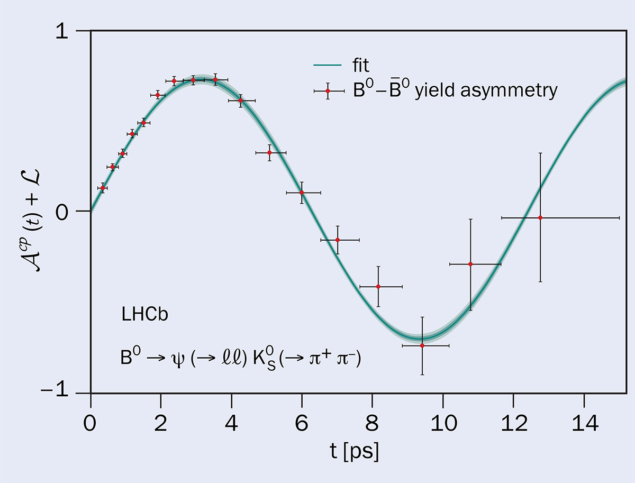A report from the LHCb experiment.

Charge-parity (CP) violation parameters in tree-dominated b → c c s quark transitions are a powerful probe of physics beyond the Standard Model (SM). When B0(s) and B0(s) mesons decay through these transitions to the same final-state particles, an interference between mixing and decay amplitudes occurs, making these processes particularly sensitive to CP violation.
In the SM, B0(s) – B0(s) mixing is possible because the flavour eigenstates are not the (physical) mass eigenstates: a neutral B meson, once produced, evolves as a quantum superposition of B0(s) and B0(s) states. Due to this time-dependent mixing amplitude, an interference between mixing and decay amplitudes can lead to an observable time-dependent CP asymmetry in the decay rates. It was through the observation of this phenomenon in the “golden mode” B0 → J/ψ K0s that, in 2001, the BaBar and Belle collaborations reported the first unequivocal evidence for CP violation in B decays, for which Kobayashi and Maskawa were awarded the 2008 Nobel Prize in Physics.
As the 3 × 3 Cabibbo–Kobayashi–Maskawa (CKM) matrix that describes quark mixing in the SM is expected to be unitary, it leads to relations among its complex elements. These can be represented as triangles in a complex plane, all of them with the same area (which is a measure of the amount of CP violation in the SM). The most famous of them, the so-called unitary triangle, has sides of roughly the same size and internal angles denoted as α, β and γ. Since individually none of the CKM parameters are predicted by theory, the search for new physics relies on over-constraining them by looking for any hint of internal inconsistency. For that, precision is the key.
LHCb has become a major actor in precision studies of CP violation
Having analysed the full proton–proton collision data set with 13 TeV, and adding it to previous measurements at 7 and 8 TeV, LHCb recently brought the CP-violating parameters in B0 → J/ψ K0s and in another golden channel, B0s → J/ψ K+K–, to a new level of precision. These parameters (sin2β and φs, respectively) are predicted with high accuracy through global CKM fits and, given their clean experimental signatures, are paramount for new-physics searches. The measured time-dependent CP asymmetry of B0 and B0 decay rates is shown in figure 1 with the resulting amplitude proportional to sin2β. Similarly, the update of the B0s → J/ψ K+K– analysis with the 13 TeV data resulted in the world’s most precise φs measurement. Both angles agree with SM expectations and with previous measurements.
These legacy results for sin2β and φs from the first LHC runs represent a new milestone in LHCb’s hunt for physics beyond the SM. Along with the world-leading determination of γ (with a current precision of less than four degrees), and the discovery of CP violation in charm in 2019, LHCb has fulfilled and exceeded its own goals of more than a decade ago, becoming the major actor in precision studies of CP violation. LHCb is taking data with a brand new detector at larger interaction rates than before, boosting the experimental sensitivity and tightening the grip around the Standard Model.
Further reading
HFLAV 2022 arXiv:2206.07501 and online updates.
LHCb Collab. 2023 LHCB-PAPER-2023-013.
LHCb Collab. 2023 arXiv:2308.01468.







